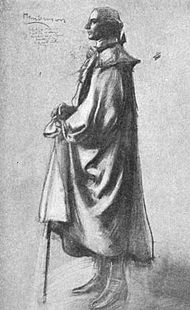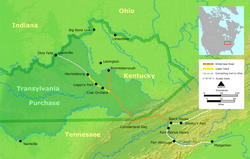Richard Henderson (jurist) facts for kids
Richard Henderson (born April 20, 1735 – died January 30, 1785) was an American judge and a person who bought and sold large areas of land. He is most famous for trying to create a new settlement called the Transylvania Colony in what is now Kentucky.
Places like Henderson County and its main town, Henderson, Kentucky, are named after him. He also sold land for an early settlement that later became Nashville, Tennessee.
Richard Henderson was born in Virginia. When he was a child, his family moved to North Carolina. There, he studied law and became a lawyer. In 1763, he married Elizabeth Keeling and they had six children.
Henderson became a judge in 1768. But he left that job in 1773 to focus on buying and selling land. In 1774, he started the Transylvania Company for this purpose. Between 1775 and 1783, he worked on many land deals in Kentucky, Tennessee, and Virginia. This included the big Transylvania Purchase and Colony. However, these deals were later canceled by the governments of Virginia and North Carolina by 1783.
Henderson's Transylvania settlement was one of the reasons for the start of the Cherokee-American wars. After his land deals ended, he returned to North Carolina. He held several important government jobs there. He died at age 49 at his home in North Carolina.
Contents
Early Life and Law Career
Richard Henderson was born in Hanover County, Virginia Colony, on April 20, 1735. His parents were Samuel and Elizabeth Henderson. In 1745, his family moved to Granville County, North Carolina.
There, he learned about law and became a lawyer. In 1768, he was chosen to be a judge for the Superior Court. In 1763, he married Elizabeth Keeling. They had children named Fanny, Richard, Archibald, Elizabeth, Leonard, and John.
Richard Henderson was seen as an important person in society. Because of this, he was sometimes targeted by a group called the Regulators. He was also a member of a church in Williamsboro. In 1773, Henderson left his job as a judge. He wanted to focus on his real interest: land deals.
The Transylvania Company and Colony
After working as a lawyer for a short time, Richard Henderson started a land company. This was on August 27, 1774. He worked with other important people from North Carolina. The company was first called Richard Henderson and Company. Then its name changed to the Louisa Company. Finally, on January 6, 1775, it became the Transylvania Company.
The Transylvania Purchase
In March 1775, Henderson met with leaders of the Cherokee Indians. They signed a deal called the Treaty of Watauga. This happened at Sycamore Shoals in what is now Elizabethton, Tennessee. Henderson bought a huge amount of land. This land was located between the Cumberland River, the Cumberland Mountains, and the Kentucky River. It was also south of the Ohio River.
The land he bought was about half the size of the entire state of Kentucky today. To help people move there, Henderson hired Daniel Boone. Boone was a famous hunter who knew Kentucky well. Boone's job was to create the Wilderness Road. This road went through the Cumberland Gap and into the Transylvania land. Henderson also bought land for the "Path Grant." This made it easier to get to the Transylvania lands.
Henderson also offered rewards to other explorers. He offered Joseph Martin a job. Martin would keep track of new settlers moving west. Henderson also gave Martin's brother, Bryce, a large piece of land. This land was near the Cumberland Gap.
The Transylvania Compact
Henderson followed Daniel Boone to a place called Boonesborough. This town was on the Kentucky River. Henderson encouraged the few settlers there to hold a special meeting. This meeting was to create a set of rules for their new government.
In May 1775, under a huge elm tree, they wrote down these rules. This plan for government included leaders, lawmakers, and courts. After finishing the Transylvania Compact, Henderson went back to North Carolina. He asked the American Congress to make Transylvania the fourteenth colony.
However, Congress would not agree. They needed permission from Virginia and North Carolina. Both states said they owned the land. In June 1776, Virginia's government stopped the Transylvania Land Company. They said the company could not demand money from settlers. In December 1778, Virginia said the Transylvania claim was not valid. North Carolina also canceled the Tennessee part of the purchase in 1783. Instead, Henderson and his partners received a grant of 200,000 acres of land. This land was on the Ohio River.
Later Life and Legacy
In 1778, Henderson briefly returned to being a judge. But he soon left to work on more land deals. In 1779–80, he led another group of settlers into Tennessee. There, he helped start a settlement called Fort Nashborough. This place is now Nashville.
In 1779, Judge Henderson was chosen to help mark the border between Virginia and North Carolina. He also served as a captain in the North Carolina militia during the Revolutionary War. He was a lawmaker for Granville County, North Carolina in 1781. He was also chosen to be a state advisor in 1782-83.
Richard Henderson died at age 49 on January 30, 1785. He was buried on his farm in North Carolina.
One of his sons, Leonard Henderson, became a Chief Justice of the North Carolina Supreme Court. The town of Henderson, North Carolina was named after Richard Henderson. Another son, Archibald Henderson, was also a lawmaker.
In western Kentucky, on the Ohio River, an early settlement grew into the town of Henderson, Kentucky. This town was named after him in 1797. Later, Henderson County, Kentucky was also named for him.
During the Treaty of Sycamore Shoals, a Cherokee leader named Dragging Canoe spoke against selling Cherokee land. He then left the main Cherokee tribe. He formed a new group called the Chickamauga. This group became important in the later Cherokee-American wars. These wars happened because of the new settlements.
Richard Henderson's childhood home in North Carolina, called Ashland plantation house, was added to the National Register of Historic Places in 1973.




